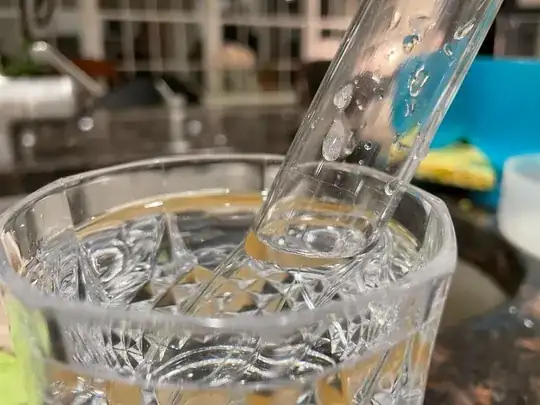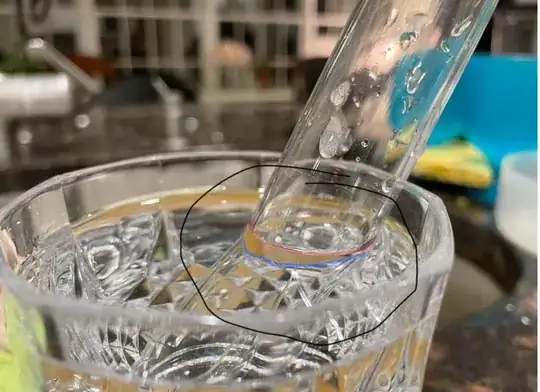The first photo is the original photo I took, while the second one has a faint red outline of the surface level of the water inside the tube and a faint blue line on the surface level of the cup. The circle is there to help locate the lines. Please answer my question. I searched it up, and I saw something about capillary action, but I don't know why the other side doesn't also climb up the sides. The cup has absolutely no ice in it, only a glass of water and a tube that's OPEN at both ends.
2 Answers
It's mainly due to the effects of surface tension and the constant value of the angle of contact between water, air and the solid surface.
We can prove it, combining the Young-Laplace equations with Stevino's law for the fluid. We assume here that the curvature of the free surface is small so that its curvature can be approximated with a second order derivative.
Coordinates. I'm using here a 2D model to keep the computation as simple as possible. I introduce here a Cartesian reference frame with the origin at the intersection of the free surface and the axis of the pipe, coincident with the $\xi$-axis pointing upwards, and the $\eta$-axis orthogonal to it. Let's define the angle $\alpha$ as the angle between the vertical $z$-axis pointing upwards and the $\xi$-axis. With these reference frames we can define the transformation rule to get
$z = \xi \cos\alpha - \eta \sin\alpha$
The free surface is described here as the (unknown) function $\xi_s(\eta)$, that can be describe using $z$-coordinate as $z_s(\eta) = \xi_s(\eta) \cos\alpha - \eta \sin\alpha$.
From Young-Laplace and Stevino to ODE for the shape of the free surface. 2D Young-Laplace equation for small curvature of the free surface becomes
$\Delta P = \gamma \kappa$ $\qquad \rightarrow \qquad P_{a} - P(\eta) = \gamma \, \xi_s''(\eta)$
being $\Delta P$ pressure jump across the free surface, $P_a$ the approximately uniform pressure in the air on the free surface, $P(\eta)$ the pressure in the fluid at the free surface, $\kappa \sim \xi_s''(\eta)$ the curvature of the free surface.
Now, we can use Stevino's law to explicitly write the pressure in the fluid $P(z) = P_0 - \rho g z$, being $P_0$ the pressure in the fluid at the height of the origin of the reference frame $0$, for which $\xi=0$, $\eta=0$ and thus $z=0$. Using coordinate transformation $z(\xi,\eta)$ we can write pressure on the free surface as
$P(\eta) = P_0 -\rho g \cos\alpha \, \xi_s(\eta) + \rho g \sin\alpha \, \eta$,
and write insert into the Young-Laplace equation to get an ODE for $\xi_s(\eta)$
$\gamma \xi_s''(\eta) - \rho g \cos \alpha \xi_s(\eta) = P_0 - P_a - \rho g \eta \sin \alpha $.
Three conditions are provided to solve the $2^{nd}$ order ODE and find the unknown value of the pressure $P_0$. These conditions are:
- free surface passing through the origin, for our choice of the reference frame:
- $\eta_s(0) = 0$
- angle of contacts, and thus surface derivative, at the solid walls:
- $\eta_s'(-\ell/2) = -\theta$
- $\eta_s'(\ell/2) = \theta$
Solution of the ODE. The solution of the linear ODE is found as the sum of a particular solution and the solution of the homogeneous equation,
$\xi_s(\eta) = A \cosh(c \eta) + B \sinh(c \eta) + \eta \tan\alpha + \dfrac{P_a - P_0}{\rho g \cos\alpha}$,
having defined the constant $c = \sqrt{\frac{\rho g}{\gamma}}$ This constant has the physical dimension $\dfrac{1}{\text{length}}$, so that it can be interpreted as c characteristic length of the capillarity phenomena. The value of the constants $A$, $B$ and the pressure $P_0$ are evaluated prescribing the 3 boundary conditions, to get
$A = \dfrac{\theta}{c \sinh ( c \ell/2)}$
$B = -\dfrac{\tan\alpha}{c \cosh(c \ell/2)} $
$P_0 = P_a + \rho g A \cos \alpha$,
and the solution
$\xi_s(\eta) = A \left[ \cosh\alpha - 1 \right] + B \sinh(c \eta) + \eta \tan \alpha$.
Now, we can write the solutions using coordinate $z_s(\eta)$ as
$z_s(\eta) = \xi_s(\eta) \cos\alpha - \eta \sin\alpha = $
$\qquad = A \left[ \cosh(c \eta) - 1 \right] \cos\alpha + B \sinh(c \eta) \cos\alpha +\eta\sin\alpha - \eta\sin\alpha =$
$\qquad = A \left[ \cosh(c \eta) - 1 \right] \cos\alpha + B \sinh(c \eta) \cos\alpha $.
Interpretation of the results. The solution can be written as the sum of two terms: the first term is an even contribution with positive second derivative, and it coincides with the solution of the vertical pipe, $\cos\alpha$. The latter term is an odd contribution with negative slope, because $B \lt 0$, explicitly
$z_s^{odd}(\eta) = -\dfrac{\sinh(c \eta)}{c \cosh(c \ell/2)} \sin\alpha$.
Evaluating $z_s^{odd}(\eta)$ in $\eta = -\ell/2$ and $\eta = \ell/2$ we get the height difference of the points of contacts, i.e.
$\Delta z_s = z_s^{odd}(\ell/2) - z_s^{odd}(-\ell/2) = - 2 \dfrac{\sinh(c \ell/2)}{c \cosh(c \ell/2)} \sin\alpha = - 2 \dfrac{\tanh(c \ell/2)}{c} \sin\alpha$.
If we evaluate the ratio of this difference of height with the width of the pipe $\ell$ we can evaluate the relative dimension of this phenomenon w.r.t. to a macroscopic dimension of the problem, readily
$\dfrac{\Delta z_s}{\ell} = - \dfrac{\tanh(c \ell/2)}{c \ell/2} \sin\alpha$,
that goes to zero as the dimension of the pipe increases $c \ell \rightarrow \infty$, so that we can assert that this phenomenon is negligible in large pipes, as we could imagine.
- 13,368
That actually looks like an optical illusion, to me. Notice how you don't see the same tilt when you look at the water on the far side of the straw. Try taking the same picture at multiple angles, and see how it changes. I think you'll find that the degree of observed tilt depends on the angle of observation, another clue that it's an optical effect. You could also get pictures from the other side, too.
Basically, when the light goes from water to glass(?), glass to air, or water to air the path gets bent (see: Snell's law). This bending can lead to some unexpected phenomena: total internal reflection, apparent depth depending on viewing angle, etc.
- 22,927

